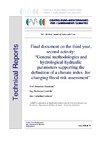This report is the final document related to the third year, second activity whose title is : “General methodologies and hydrological-hydraulic parameters supporting the definition of a climate index for changing flood risk assessment”.
The purpose of the collaboration between LAMPIT (department of Soil Defence, University of Calabria) and CMCC is to develop an hydrometeorological chain in order to obtain a reliable tool in the context of flood evolution prediction able to provide quantitative information of practical importance within the civil protection activities.
The LAMPIT contribution to the project concerns the mathematical description of both generation and propagation of flood events at basin scale. The work here presented has been carried out in close cooperation with dr. Pasquale Schiano and dr. Paola Mercogliano.
In order to embrace the problem as a whole, this report starts from a general overview of the characteristics of climate change according to IPCC evaluations, highlighting the main causes that may induce a variation of flood features (chapter 1). The term “flood” is often generically associated to a number of natural events that significantly differ in terms of phenomenological generation. So it seems necessary to recall in mind a possible main classification of flood phenomena in order to underline the flood type discussed herein and his peculiarities in relation to climate change (chapter 2). In a catchment-wide perspective there is the need to take into account non-climatic drivers, such as land-use change, in the evaluation of changing flood risk: land cover change within a watershed is recognized as an important factor affecting runoff and it is possible that the transformation of land across the globe could have a greater influence on runoff than climate change; that question is explained in the chapter 3.
Chapter 4 is devoted to the general methodologies developed to evaluate the effects of climate change on runoff. They are mainly based on the interconnection between climate and hydrologic models; some features of each model are also analysed to highlight those aspects useful for the evaluation of climate impact on river flooding that link climate models to hydrological model. In order to better characterize the general methodologies, a number of typical results, presented in the literature, are illustrated in the chapter 5.
The analysis related related to the impact of climate change on flood risk is affected by a significant degree of uncertainty; some consideration on the uncertainty source is presented in the chapter 6. Finally in the chapter 7, the concept of climate elasticity of streamflow, considered to be an important indicator identifying the sensitivity of streamflow to climate change, is presented.
CMCC Institutes
CMCC Divisions
Authors
- Keywords: Flood propagation, Hydrometeorological chains


